As of today, the US has 11 carriers in commission. Ten are of the Nimitz class, a design dating back to the late 60s. The last is the USS Gerald R Ford, the first ship of a new design that will take American Naval Aviation through the 21st century. She promises to bring significant new capabilities to carrier operations, as well as lower operating cost, but the addition of new technologies has made her development difficult even by the standards of new warships. But it appears that things have finally settled down, with her maiden deployment planned for later this year.1
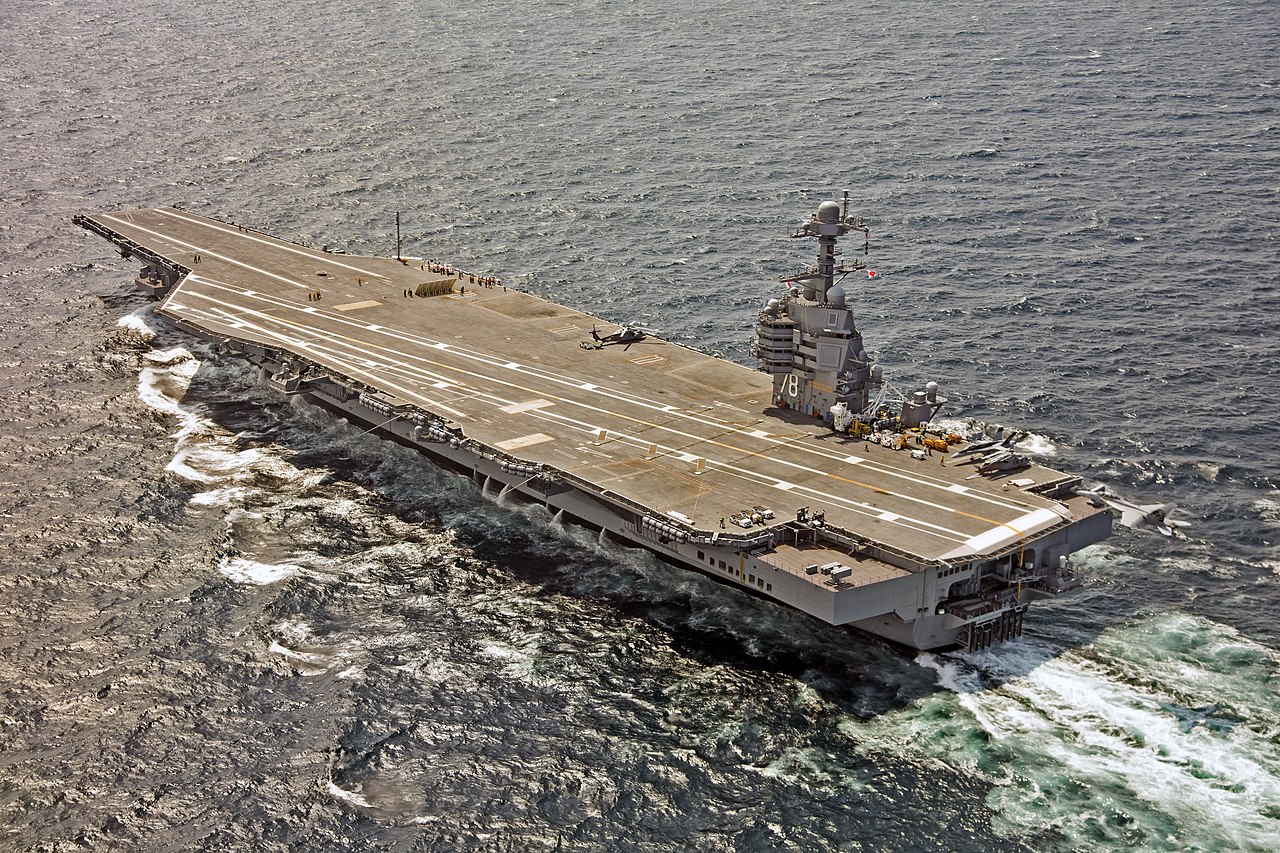
Gerald R. Ford takes aboard a Super Hornet
But before we turn to the sordid history of the Ford class, it's worth taking a look at the changes that have been made to make them the most capable aircraft carriers ever built. While the basic hull is very similar to the Nimitz class, a result of the need for the new ship to fit into existing drydocks, the internals are quite different. In line with general trends in warship engineering, the new ship would make considerably greater use of electrical power for its systems, which generally means greater reliability, lower maintenance, and better resistance to damage. This is most notably seen in the new Electromagnetic Aircraft Launch System (EMALS), which replaces the traditional steam-powered catapults with a linear induction motor to fling the aircraft off the deck. This offers the possibility of finer control of the catapult shot, as the existing steam catapults have no feedback and are not well-suited to dealing with very light aircraft, such as potential future UAVs. Concerns about reliability, weight and the ability to trap light aircraft prompted a similar redesign of the arresting gear.
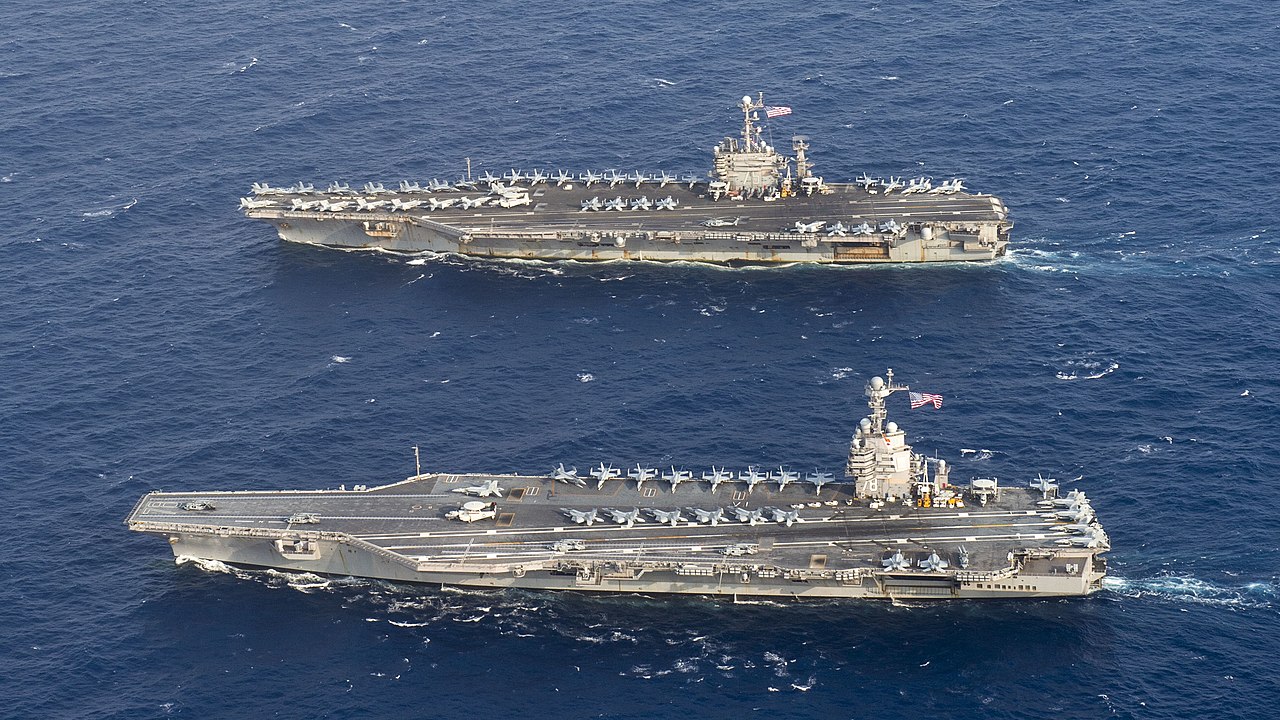
Ford (bottom) alongside Truman
The other major driver of changes to the new design was the arrival of precision weapons. Before, carriers had been designed to produce a few alpha strikes, with lots of aircraft arriving over the target at the same time. This had been the best way to destroy targets in the age of iron bombs, but with weapons like JDAM, it makes sense instead to prioritize number of sorties, even if it means getting fewer planes into the air at any one time. This involves major changes in how the flight deck is laid out, with a single "pit stop" location for arming and refueling. The weapons themselves would be supplied by improved weapon elevators, driven by linear induction motors that should make them faster and safer than conventional elevators. The end result would be capable of generating 160 sorties a day sustained and surge up to 270 per day for short periods, as opposed to 120 and 240 for the Nimitz. The aft elevator on the starboard side was deleted, and the island moved 140' aft and made considerably smaller. This was enabled by the adoption of a new dual-band radar, which integrated two separate phased array radars, one for short-range search and weapon guidance and one for longer-range search, replacing the forest of radar antennas that defined the island of the Nimitz class.
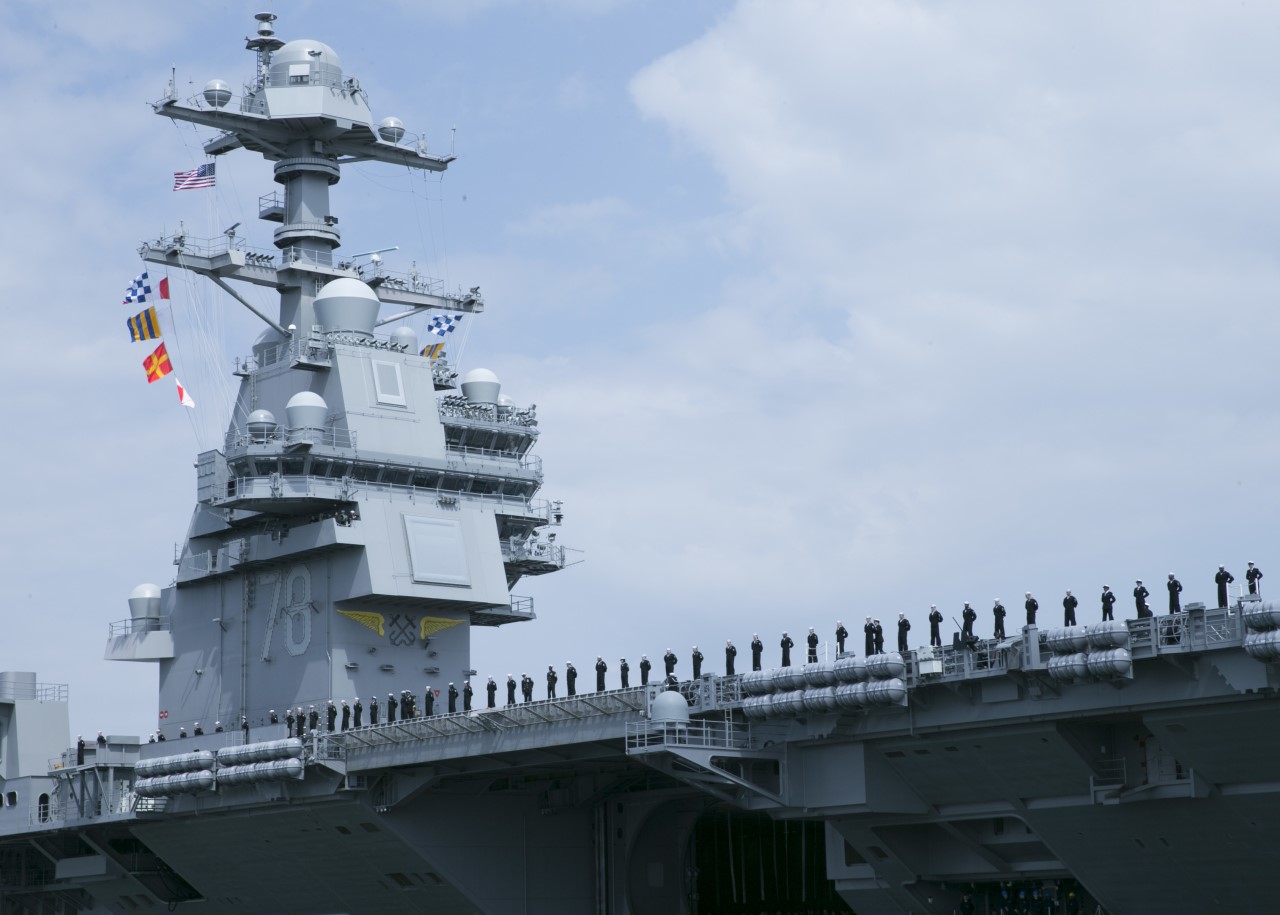
Ford's island, showing only the dual-band radar and satellite dishes
The net result of all of this, and a wider use of electrical systems for things like heating and cooking, is a ship that should require significantly less manpower, almost always the biggest cost to any military. Sources vary somewhat, but it appears that Ford has a core crew of about 2,800, with another 1,800 embarked from the airwing, a savings of 1,100 sailors relative to a Nimitz. The need to keep them happy (and thus reenlisting) means that habitability is significantly better, with fewer bunks per space and separate recreation areas to hold down noise. A new reactor, the Bechtel A1B, powers the ship, and the lack of steam catapults has allowed the steam system to be greatly simplified, even as it produces 2.5 times as much electrical power as the Nimitz.
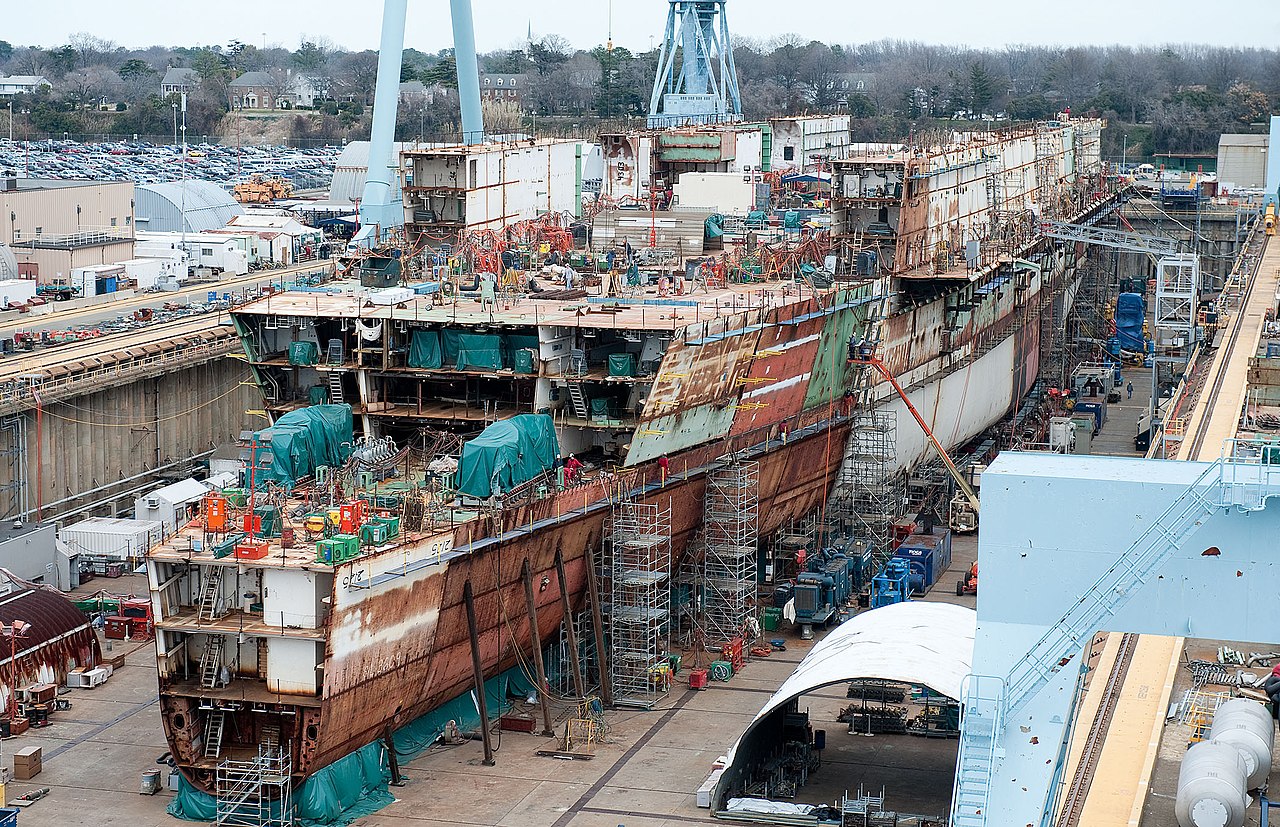
Ford under construction
This is a daunting list of changes, particularly when compared to the half-century of stability in carrier design that proceeded it, and in the late 90s, the Navy planned to roll them out across three ships, CVNs 77 to 79, with most of the big changes, like the new reactor and EMALS, arriving with CVN-78. Into this picture came the Bush Administration, and its Secretary of Defense, Donald Rumsfeld. Rumsfeld's buzzword was "transformation", which had been intended to involve the questioning of how things were done, but rapidly morphed into doing things differently for its own sake. The three-ship integration of new systems was rejected as insufficiently Transformational, and the plan was altered to order CVN-77 as a near-repeat of CVN-76 to reduce risk, while all of the various advances would be pulled forward into CVN-78, which was finally ordered from Newport News Shipbuilding in 2008.
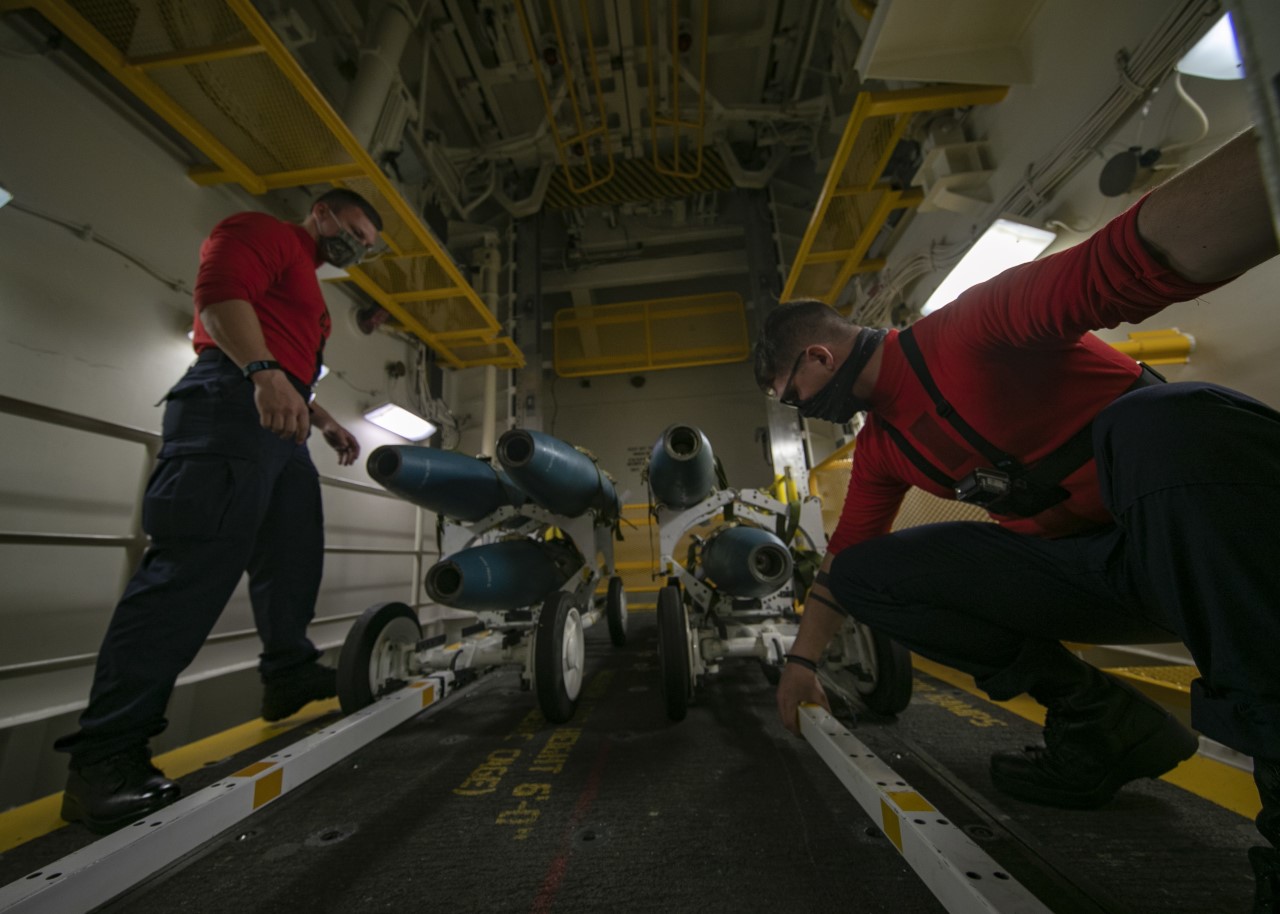
Sailors move bombs through an Advanced Weapon Elevator
The result of this change was entirely predictable, particularly to those familiar with the other victims of Rumsfeld's Transformational DoD. The original plan was to deliver CVN-78, named after president Gerald R. Ford, in 2015, at a cost of $10.5 billion in FY08 dollars. Cost ballooned at least 30%, and various problems meant that when the Navy finally got the ship in 2017, there was still a great deal of work to be done. Both EMALS and the AAG had serious reliability issues, while the new weapon elevators basically didn't work. They involved a complex series of interlocks to seal the magazines off from the assembly areas and flight decks, and getting everything working together proved extremely difficult. Fixing them took until late 2021, when the last one was finally delivered to the Navy.2 The dual-band radar, which had also been planned for installation on the Zumwalt, ran into delays of its own, to the point where it was dropped from both the destroyers and later units of the Ford class. CVN-79 and later ships would instead receive a reduced version of the AN/SPY-6, mounted to rotate so a single array can cover the entire area around the ship.
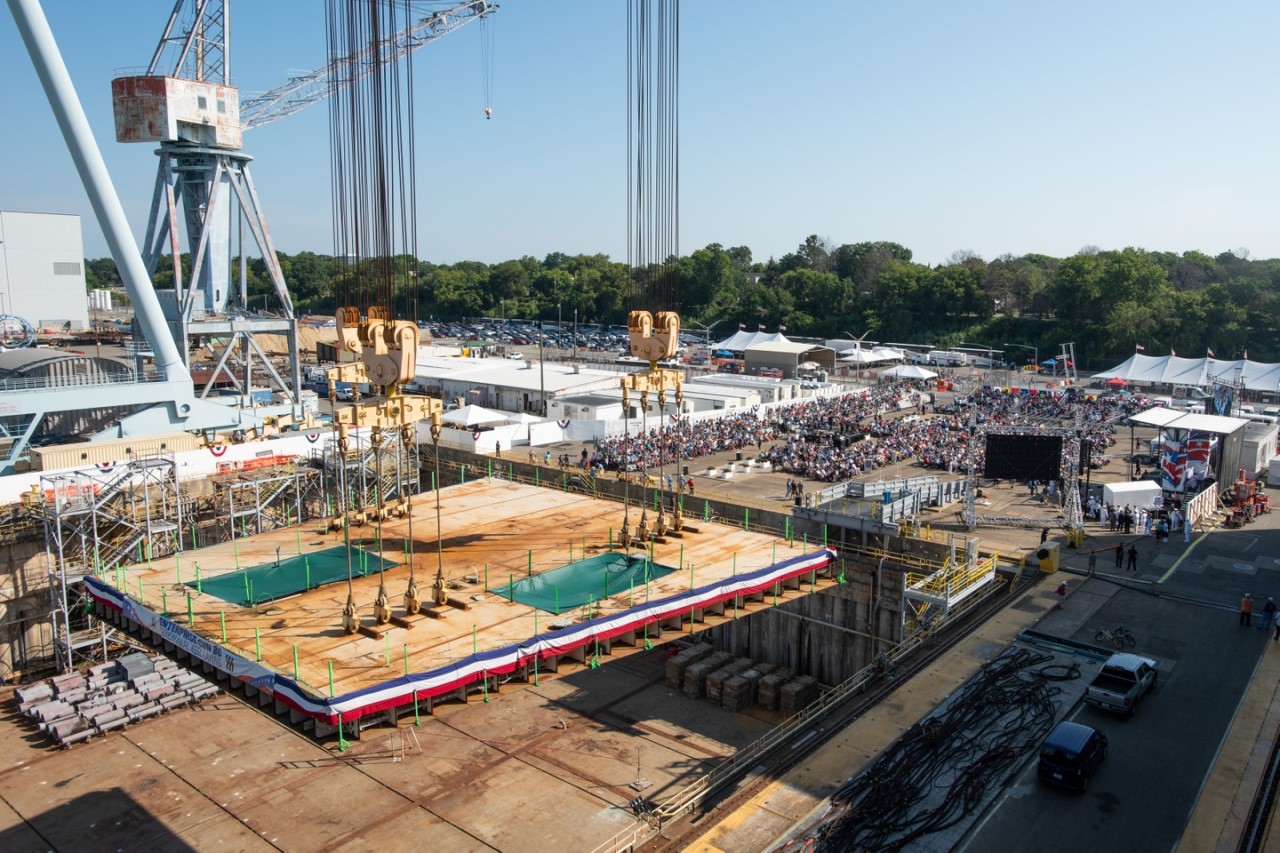
The keel is laid for CVN-80, future USS Enterprise
Despite the numerous problems it has faced, the Ford program is in far better shape than its contemporary surface warships. Although issues with the new systems meant that Ford has been in commission for over five years without making a proper deployment, the cost has been under control for the last decade, and things seem to be going well on the follow-on ships. John F. Kennedy (CVN-79) is currently fitting out, while Enterprise (CVN-80) was laid down in 2022, and a fourth unit, Doris Miller, has been ordered.3 Current plans call for six more units to be built in the coming decades. They will form the backbone of the American carrier fleet when the Nimitzs retire, and give US naval aviation the capabilities it needs for the 21st century.
1 The Navy claims that her first deployment took place in October-November 2022. I decline to participate in their spin on the grounds that we normally deploy carriers for about 6 months at a time, not 2, and I'm going to count when she provides useful deployed firepower. ⇑
2 To be clear, it was installed on the carrier while it was under construction, but remained property of the manufacturer until they got it working. Defense procurement is weird. ⇑
3 I would like to note that I despise this name. I have nothing against Doris Miller, but the name is clearly one that belongs on a destroyer, not a carrier, and indeed he got a Knox class frigate back in the 70s. I would have used Yorktown or Lexington, both of which have been idle for a while. ⇑

Comments
I don't care for the name Doris Miller, Yorktown or Lexington would have been far more appropriate. But if it gets the carrier built, I'd say it's better than Gerald R. Ford, the only unelected president.
In fairness, Ford was actually President, which is the current system. I don't love it, and would have preferred we got a Yorktown class or something, but Miller is so clearly not in the scheme that it really bothers me.
Within the presidential naming schemes, I suppose we'd be particularly interested in Presidents with a personal connection to the Navy in general and to carriers in particular.
Presidents I can think of who, as President, had a notable role in expanding or overhauling the US Navy are (in chronological order) John Adams, Abraham Lincoln, Chester Arthur, Grover Cleveland, Theodore Roosevelt, Franklin Roosevelt, and Ronald Reagan. Maybe William Taft, too, since I think the Standard Battleships were first ordered during his administration. And the two Presidents I can think of who served in the Navy were Jimmy Carter and George H.W. Bush, the latter of whom was a naval aviator.
I think all but Adams, Arthur, Cleveland, and Taft already have warships currently in service named after them, mostly carriers (FDR has a destroyer named after him, and Carter an attack sub). Of those, Adams is probably the best candidate, since Arthur is largely forgotten, Cleveland remembered mainly for serving non-consecutive terms, and Taft remembered mainly for the apocryphal story of him getting stuck in the White House bathtub.
We should name carriers for apollo landing sites. USS Ocean of Storms and Sea of tranquility are great names. Plus they all carry the implication of "USS someplace we're cool enough to go but you aren't"
cassander:
But you haven't continued going there.
Gerald Ford has served in the Navy, he was almost lost at sea during Halseys' Typhoon.
The advantage of Cassander's proposed scheme is, if the Navy wants to have more than six aircraft carriers, we have to go back to the Moon.
Or Mars. Lots of good warship names on a planet named for the God of War.
It feels kinda off to name a warship after a place that doesn't have any bodies of liquid water. Although I suppose there we could lean on the precedents of naming battleships after landlocked states (Arizona, Iowa, Montana, etc).
@Eric Rall
We have gone over this a few times. The only thing keeping Iowa from coming home to Davenport is the bridges.
@cassander
You could even put a moon rock under the name-plate to stike extra fear in the hearts of the enemies of the republic.
Eric Rall:
Only because the US Navy is so primitive that they're operating waterships.
Eric Rall:
No such Battleship.
No such battleship was built, but the USS Montana (and the other planned Montana Class battleships) were planned and even ordered before being cancelled in 1943. If a battleship is ordered and a name officially assigned to it, I think that's enough to establish a precedent that the assigned name is considered a valid name for a capital ship.
If I had a mandate for the First Carrier Named After A Black Person (this is pretty transparently what happened), I would choose Doris Miller as a temporary kludge, then rename her to Barack Obama after the former POTUS dies. No special relationship to the Navy, sure, but a President is a President.
I very strongly dislike renaming ships. I have very mixed feelings on the recent announcement about Chancellorsville, and that's a battle that should never have gotten a ship. Cynically, I do wonder if Dorie Miller was trying to preempt a USS Obama, although he hasn't been out of office quite long enough for that even by the relaxed standards of today.
Johnston would be an appropriately venerable name.
Aye, but Johnston (or for that matter Hoel) would befit a destroyer or frigate, or at a great stretch, a cruiser.
If I was to become SecNav, I would absolutely use Hoel as probably my first destroyer name. Johnston and others would not be far behind. But those belong on destroyers, not carriers.
I recall seeing some speculation when ideas for the new FFGs were mooted that the first one might be named Ernest Evans, which would be pretty fitting IMHO as well.
That would have been a good name, and I would have been very happy with "Samar" as the naming theme. I would lead with Hoel for personal reasons (knew a survivor, never met anyone off Johnston) but wouldn't argue with anyone who picked a different order of ships and men.
I know a Samar vet too, but he was on Raymond, and is pretty unwilling to talk about it. IIRC Raymond was the only ship undamaged in the fighting, or at least where nobody died.